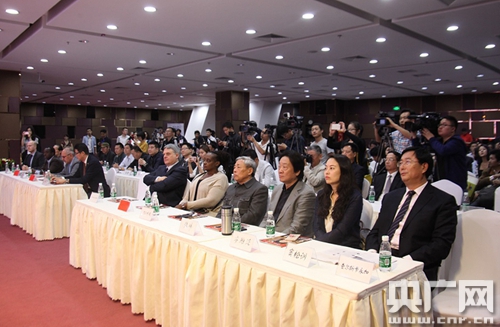Zheng Yongnian: China's Great Northwest Issues
Zheng Yongnian: China's Great Northwest Issues
On April 9, 2019, he posted an article called "China's Great Northwest Issues", which immediately brought the Xinjiang issue to the Northwest level to talk about it. Zheng Yongnian started with historical changes, talked about how problems were accumulated step by step, and also proposed some solutions.
Zheng Yongnian is good at studying China's politics and economy.
On April 9, 2019, he posted an article called "China's Great Northwest Issues", which immediately brought the Xinjiang issue to the Northwest level to talk about it. The Xinjiang issue is related to the stability and development of the entire northwest region.
Zheng Yongnian started with historical changes, talked about how problems were accumulated step by step, and also proposed some solutions.

China has been under a lot of international pressure in recent years. Western media are watching the US-China trade war, the South China Sea, and the internal Xinjiang issues.
Zheng Yongnian feels that Xinjiang is just the tip of the iceberg, and the northwest, including Muslim settlement areas such as Xinjiang, Gansu and Ningxia, have a wider problem. He stressed that solving problems cannot be done with the surface, but with the root cause.
Since the 1980s, policies have changed and the situation has changed.

The first root cause is the "liberalization" policy in the 1980s. At that time, in order to correct previous extreme practices, the central government promoted loose management in ethnic minority areas, hoping to narrow the distance through development and stabilize people's hearts.
The idea is good, but it will be distorted if implemented. Many people in the local area understand this as the government should withdraw, especially religious affairs.
As a result, there are too many mosques in Xinjiang, which are more than those in the Middle East, such as Saudi Arabia and Türkiye, based on population proportion. The construction is unplanned, it is messy, and it is messy.

If you want to control it now, the rebound will definitely be big. This is not only Xinjiang, but also churches. Zheng Yongnian said that this anarchy is the starting point of the problem and the executive level has not kept a close eye.
The second is the market-oriented impact in the 1990s. As the planned economy disintegrated, all aspects have changed.
In the past, housing was divided by the state, and multiple ethnic groups lived in the city, and medical education basically covered the grassroots level, forming a preliminary community. When the market economy comes, everything goes by money and the community is dispersed.

Nowadays, people of all ethnic groups live separately and join each other, making it easy to have rifts between each other. Xinjiang used to be a glory for cross-ethnic marriage, but now it has become a betrayal.
In terms of cultural education, loose policies have no money to keep up, scholars and students go abroad to study and find funds to foreign countries, and radical ideas from Saudi Arabia have been passed back.
After returning to China, they became communicators, and Wahhabiism became popular in Xinjiang. This has a big impact, and identity has become stronger.

The third is a major change in population proportion. In the past, the government encouraged the Han people to move in through the Xinjiang Production and Construction Corps and other methods to promote integration and development. The population movement is normal, which not only allows ethnic minorities to go to the mainland, but also allows Han people to come to the frontier. Or it would be quarantine.
But later the situation reversed and the Han people became a minority in Xinjiang.
Why? First, the population policy is uneven, the Han people are limited to one child, and there are many ethnic minorities; second, a large number of descendants of the Corps return to the mainland to find jobs; third, the environment is deteriorating, making it difficult for newcomers to enter. Nowadays, except those who do business, few people are willing to live for a long time. This change makes integration difficult.

The fourth is unequal ethnic policy.
Originally, universal policies such as housing and medical education should have been brought closer, but the special preferential policies have been brought farther away. In the early days, 55 ethnic minorities were identified according to the Stalin model, and then there were many discounts, and education and employment were tilted. Logically speaking, particularity is separated.
When officials deal with problems, they are afraid of being sensitive and no one dares to touch them. The local government will let them go, and small matters will accumulate to cause great disasters. Zheng Yongnian compared it to the Western political correctness. The executive level is not responsible and the problem breaks out at any time.

The fifth is the pan-Muslimization in the northwest.
There are many Muslims in Xinjiang, Ningxia, Gansu, and the problems are different, but they are all affected by globalization. Externally, the chaos in the Middle East, Turkey's ambitions, the United States and Central Asian strategies, and the active forces in the East Turkish region. Once these forces are combined, they are under great pressure; internally, religious identity turns into political identity, and secular conflicts.
Halal food is sold everywhere in the market, and social media is fueling the fire, from business to school governments, strengthening Muslim identity.

The sixth is new risks. From the Qin Great Wall to the Ming Dynasty, defense against the west was a tradition. The opening-up policy is good now, but China is unstoppable to advance the "Belt and Road" and the integration of western forces. Zheng Yongnian mentioned "Great Wall Culture" not to be closed, but to be a defensive mechanism, and he had to think of an alternative solution clearly.
These root causes are policy implementation, market changes, population mobility, identity strengthening, and geopolitical pressure superposition. Zheng Yongnian's analysis was quite honest and had no time to talk about the big truth, and pointed out the pain points directly.
So how to solve it? The ideas given by Zheng Yongnian are practical.
First, distinguish "anti-terrorism" and development, strictly control extremists, promote training for others, and employment language is normal. But it cannot be disturbed. In terms of policy, everyone in ethnic areas is equal, including the Han people.
Religious affairs are established and regulated by the government, from political management to rule of law management, and learn from those in the West and Singapore that are strictly managed. In terms of integration, reduce special discounts and promote more general social policies: social security, housing, education, and employment.
These are all benefits and come naturally. Externally, balance open defense, focus on commerce, and not destroy the Great Wall culture.

Internationally, those reports of Human Rights Watch criticized China's Xinjiang, but Zheng Yongnian in turn said that Western doubts can help China reflect on governance.
Xinjiang governance has made progress in 2025. The work report of the Autonomous Region Government on January 29 said that it was 100 million yuan in the first half of the year, an increase of 5.7%. The primary industry is 5.2%, and the top ten industrial clusters are being promoted, and new energy, textiles and other efforts are being made.
The central government has used 14.9 billion yuan of rural revitalization funds to connect farmers and lead farmers to build 15 beautiful and livable villages. Learn the "Ten Millions of Project" in Zhejiang, and the Gobi Desert turns into an oasis.

The Two Sessions announced on January 22 that industrial clusters will be accelerated and high-quality development will be developed in 2025. Ecologically, the northern slope of Tianshan Mountains is jointly defended, Takrama dry-locked edges, and Shagohuang New Energy Base is built.
On January 11, the Plenary Session of the Autonomous Region Party Committee said that the "14th Five-Year Plan" will be concluded and the 70th anniversary of its establishment will be adhered to the new ideas and fully implemented.
On August 13, the National Development and Reform Commission held a symposium to learn the spirit of the 20th National Congress and implement the Central Economic Work Conference. On September 9, an academic seminar was held in Urumqi, discussing the strategy of governing Xinjiang in the new era, theoretical practice innovation, and demonstrating 70 years of achievements.

Desertification governance has received international praise, and China has shared its experience and established a community of life on Earth. Human Rights Watch reported on January 17 that China's crackdown escalated, and Xinjiang, Tibet and Hong Kong were hit hardest hit areas. The two sides have contradictory statements, but the fact is that economic data is impressive and is improving steadily.
General Zheng Yongnian emphasized the eternal national policy of opening up, but he had to guard against geopolitical risks. This is in line with the Northwest idea.
The problem of the Northwest is complex, with heavy historical burdens and great external pressure. However, through equal policies, development integration, and defense balance, we can stabilize it. The northwest is half of China's territory. Only when the country is well managed will the country be stable.

References:





